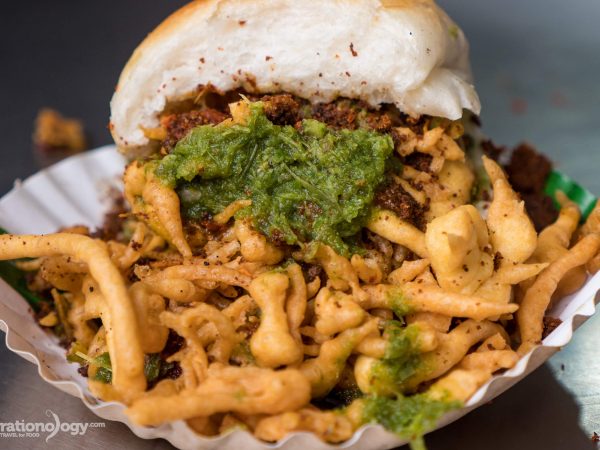

Varanasi, India, is one of the most important cities in all of India, and it’s one of the longest continually inhabited areas in the world. From the moment I stepped off the train, I was excited to start exploring this fascinating place.
But unlike Bangkok or Delhi where there are an abundance of diverse and famous attractions, Varanasi is less about hopping from one famous site to another, but rather about being absorbed into the ancient city and observing the people, ceremonies, and overall life (and death) that’s so evident.
Just exploring the narrow alleys and observing things along the mystical Ganges River is more than enough to keep one occupied and fascinated while visiting Varanasi. Be sure to also check out my Varanasi travel guide for more tips about visiting the city.
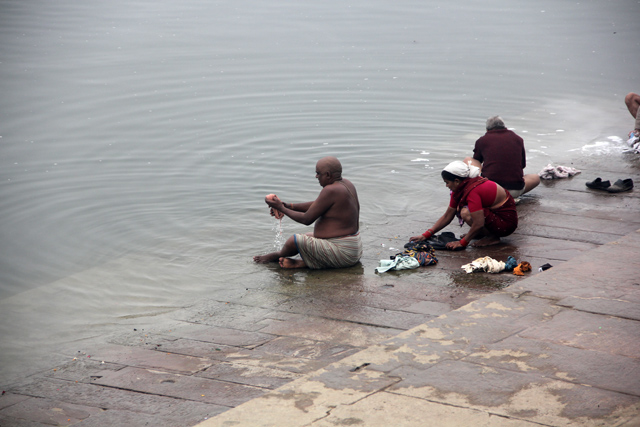
1. Varanasi Ghats
A ghat is a series of shelved steps, now normally made from concrete, that leads down to a certain holy river. In Varanasi, all along the Ganges River are ghats where people walk, congregate, and worship; The ghats also offer convenient access to the water itself. Each ghat has a name that is often painted on the side of a wall somewhere along the steps, making them easier to locate.
The Main Ghat (Dashashwamedh Ghat) is the most famous, but I thought the most interesting and picturesque ghat in Varanasi was Kedar ghat, about a 15 minute walk from the Main Ghat. Asi Ghat is about a 30 – 45 minute walk from the Main Ghat, and it’s a little lesser developed and quite laid back – some of the area doesn’t even have steps but just a muddy bank.
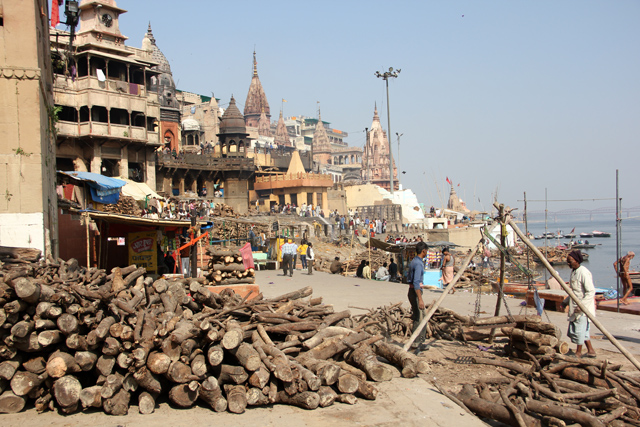
2. Burning Ghats
Varanasi is a city for both life and death in the Hindu belief.
Get exclusive updates
Enter your email and I’ll send you the best travel food content.
It’s a city where people come to bathe in an attempt to wash away their sins, and others come to die and be either cremated or sunk to the bottom of the Ganges River. In central Varanasi, there are 2 ghats where they burn bodies. The main one is known as Manikarnika Ghat, and the smaller one, where there’s more space, is the Harishchandra Ghat.
You can go up on a balcony and view the burning and the ceremonies from above. It’s truly a fascinating process to watch.
Note: Be aware of the many scams that take place, especially around the Manikarnika Burning Ghat. A group of youth will often approach you and say they are working for something like “Hospice,” taking care of the dead and would like a donation for firewood. This is a scam! Another older guy approached me and said he was a long time volunteer and even did an interview with various credible news agencies (BBC, National Geographic), and then asked for a similar donation. Also, out of respect (and all the scam guys) will let you know, there are no photos allowed. At the smaller burning ghat, they didn’t seem to mind about taking photos – but perhaps it’s up to the family of the deceased.
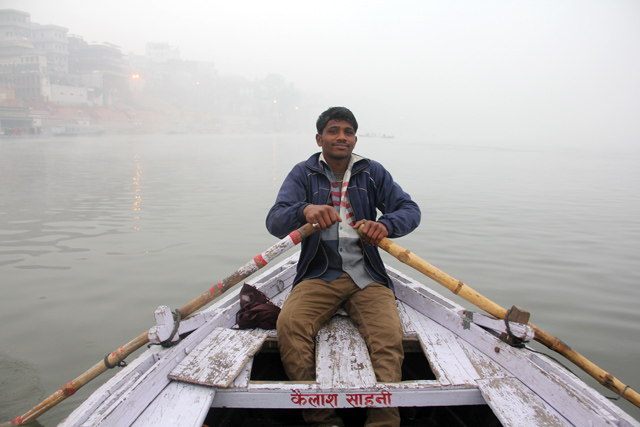
3. Boat Ride on the Ganges River
One of the most famous things to do in Varanasi is take a boat ride in the Ganges River at either sunrise or sunset. It’s a great way to observe life on the banks of the river, instead of being on the bank itself.
You’ll see people bathing, washing their clothes, and even drinking water from the Ganges. I personally took an early morning sunrise boat ride and paid 200 Rupees for a 1 hour ride for 2 of us. I got the boat near the Main Ghat and the driver paddled up to the Main Burning Ghat (we didn’t make it too far as my boat driver was lazy, but it was still magical be in a peaceful row boat at dawn on the Ganges).
Note: There are hundreds of boats, and nearly everyone will ask you if you want a ride – and no matter what time it is, they will say “it’s a very good time to take photos.” It can be confusing to try to find a good boat driver, but eventually just choose one, have a price in mind, and then stick to your price. As I mentioned, I paid 200 Rupees (for 2 of us) for 1 hour.
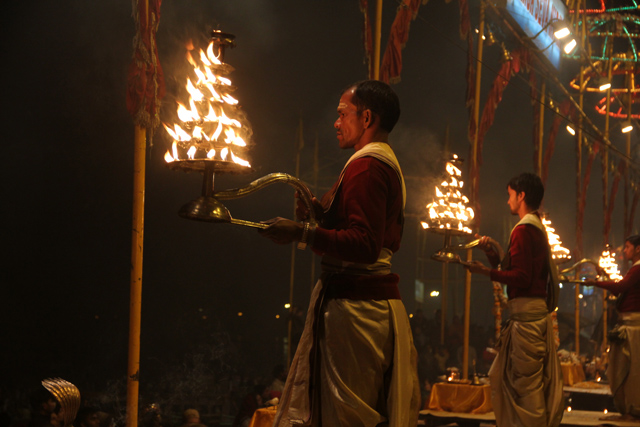
4. Night Pooja Ceremony
Every night at the Main Ghat is the Pooja Ceremony, a performance conducted by Brahmins that is dedicated to Lord Shiva and the the River Ganga. It begins around 6 pm nightly, and attracts a large crowd of Hindus and tourists each evening.
Many people just stand along the ghat steps, but others hop in boats to see the ceremony from the water. The brahmins go through a series of rituals that include lots of burning incense, fire, motions, bell ringing, and loud music in the background. It’s definitely worth seeing at least once when you visit Varanasi.
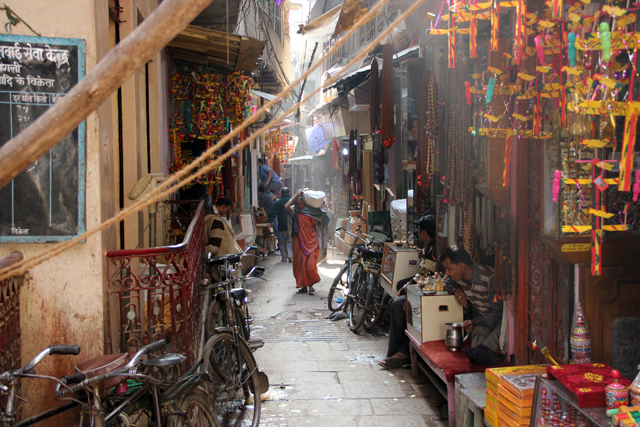
5. Ancient Alleys and Streets of Varanasi
Along with exploring the ghats and all along the Ganges River, equally as interesting is getting lost in the narrow ancient alleys of the city. Within the lanes you’ll find guest houses, restaurants, street stalls, stores and all sorts of other businesses. You’ll also encounter cows, shrines, and temples.
I spent hours just navigating and exploring these narrow streets of Varanasi, you never know what exactly you’ll find. If you hang out on the lane leading to the Manikarnika Burning Ghat you’ll have to dodge funerary processions as they march down the alley. I was eating some street food when I had to duck!
Of the things to do in Varanasi, it’s more about being there and wandering around. You never know exactly what you’ll see or come across while walking around Varanasi, but whatever happens, you can be certain it will be extraordinarily fascinating.
Also check out my Varanasi travel guide and Varanasi video.
Get exclusive updates
Enter your email and I'll send you the best travel food content.


